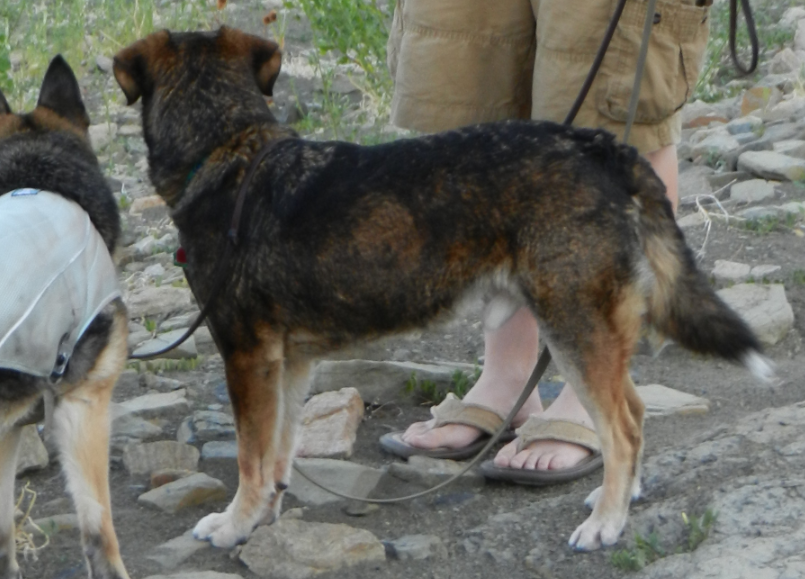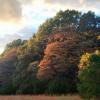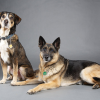12-year old Mixed Breed Dog
Forums
Trying to fill out the 'color' blank on vet forms has never been so difficult for me. My dog is of unknown ancestry. The rescue I adopted him from last year listed him as a shepherd/husky cross, but he's 42lbs and to me, that doesn't look like it explains everything..any breed guesses?
At times, I will swear I see brindle but at others I am convinced it is just the way his hair is laying. He's also got the whole unconventional "tri-colored" thing going on and some freckles. It seems like his undercoat is mostly tan but he does have some guard hairs that are tan instead of brown. Any ideas as to what color to call him?
Sidenote: He's already gotten his CGC and is in intermediate Rally classes. Adopting older dogs can make it so easy :)
Oh, thanks for the tip about
Oh, thanks for the tip about looking the whole length of the hair. Upon closer examination, he has hairs that are light almost all the way to the tip, but turn dark brown at the very ends. I was not able to find a single hair that didn't end like that along his back/sides. So it seems that he has agouti banding.
Are there certain dog breeds that are more apt to result in freckles like he has? I guess the main categories I think of when I think of dogs with freckles are pointers, spaniels, and some herding dogs (although, that may be ticking, come to think of it.)
If he were just tricolor-dark brown, tan, and white- would he be considered a dilute because of how light his facial mask is?
I found a website (which is hard to be taken seriously, since it's written in all caps and has flames everywhere, but seems to have solid information: http://www.americanironkennels.com/TriH…) that might indicate he's more of a 'dilute sable' and not a real tri-color (which seems likely to me) or some sort of an 'agouti tan-pointed tri-color' and I'm not really sure if that exists.
Then again, when you google-image search "dilute sable" that dog is about the only one that pops up. Who knows!
I think you're right about Labrador being somewhere in there.
Quote:the has hairs that are
[quote]the has hairs that are light almost all the way to the tip[/quote] Are these hairs in groups or separate?
The freckles on the nose are the result of the white pattern. It has been theorized that such freckles are the result of a white suppressor gene acting on the white pattern but there is no way to know for sure at this time. I can't really tell from the photos but I bet he has a few freckles on his paws as well?
He could have one of the dilutions that only affect red. There is alot of disagreement about how much they actually dilute red if the dog is heterozygous for the dilution. He does however fall into what I consider the "normal" range of red. If I'm seeing the right thing, the lightness on the face is because he lacks a face mask. This is fairly common in some breeds. E[sup]M[/sup] will result in the production of black pigment with black face mask, E (such as your dog) will result in black pigment without a facemask and ee (recessive to both E[sup]M[/sup] and E is a solid red or yellow dog without black pigment.
He's not what I would consider a tri-color. What I think of as a tri-color has distinct areas of tan, black, and white. It is the result of a black and tan phenotype with a white pattern. His white pattern would be called Irish Spotting and the coat it's self if not brindle could be called sable or grizzle depending on what breeds your using as reference. Although grizzle is also used for a specific phenotype in Afghan hounds I personally think it could describe him very well.




He is interesting isn't he? I
He is interesting isn't he?
I "think" he is brindle. It can be very hard to tell with a long coat especially then the dog is darker like he is. If you examine the hair along his back, is it all lighter with dark tips or is some of the hair lighter all the way to the tip? If it's all dark tipped then it's just agouti banding the hair and I'm seeing "waves" in the hair. If there are "patches" of hair that are lighter at the tips that would be a good indication of brindle.
Maybe some Lab on the cross? He looks like he might have some lab in the face.
I love the photo on the blue background. Such a sweet expression.